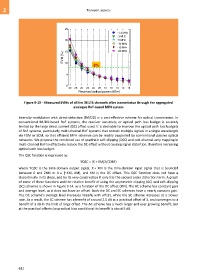Page 622 - 5G Basics - Core Network Aspects
P. 622
2 Transport aspects
64-QAM (E-UTRA), L=20km (9/9/2014), mean EVM 64-QAM (E-UTRA), L=20km (9/9/2014)
25 25
1.4-MHz 1.4-MHz
3-MHz 3-MHz
20 5-MHz 20 5-MHz
10-MHz 10-MHz
15-MHz 15 15-MHz
20-MHz
20-MHz
15
EVM (%) EVM (%)
10
10
8%
5 5
0 0
-30 -25 -20 -15 -10 -30 -28 -26 -24 -22 -20 -18 -16 -14 -12 -10
Received optical power (dBm) Received optical power (dBm)
Figure 9-13 – Measured EVMs of all the 36 LTE channels after transmission through the aggregated
analogue RoF-based MFH system
Intensity-modulation with direct-detection (IM/DD) is a cost-effective scheme for optical transmission. In
conventional IM/DD-based RoF systems, the receiver sensitivity or optical path loss budget is severely
limited by the large direct current (DC) offset used. It is desirable to improve the optical path loss budgets
of RoF systems, particularly multi-channel RoF systems that contain multiple signals in a single wavelength
via FDM or SCM, so that efficient MFH schemes can be readily supported by conventional passive optical
networks. We propose the combined use of quadratic soft clipping (QSC) and odd-channel-only mapping in
multi-channel RoF to effectively reduce the DC offset without causing signal distortion, therefore increasing
optical path loss budget.
The QSC function is expressed as:
YQSC = (X + XM)2/(2XM)
where YQSC is the time-domain output signal, X + XM is the time-domain input signal that is bounded
between 0 and 2XM or X [−XM, XM], and XM is the DC offset. This QSC function does not have a
discontinuity in its slope, and by its very construction it only has the second order distortion term. A graph
of some of these functions and the relative benefit of using the asymmetric clipping (AC) and soft-clipping
(SC) schemes is shown in Figure 9-14, as a function of the DC offset (XM). The AC scheme has constant gain
and average level, as it does not have an offset. Both the DC and SC schemes have a nearly constant gain.
The DC scheme's average level increases linearly with offset, while the SC scheme increases at a slower
rate. As a result, the SC scheme has a benefit of around 2.5 dB at a practical offset of 3, and converges to a
benefit of 3 dB in the limit of large offset. The AC scheme has a much larger and ever growing benefit, but
at the practical offsets (or practical bias conditions) its benefit is about 5 dB.
612

